Meanwhile in 1826 a famous man by the name of Thaddeus Stevens, who was then practicing law in Gettysburg, got involved in the iron industry where he and some business partners formed Maria Furnace in Adams County.
Stevens planned for the railroad to transport from "Columbia to York and Gettysburg and then through his ironworks at Maria Furnace to connect with the proposed Baltimore and Ohio line near Hagerstown. His approach to promoting such a line was that it would divert traffic from the B&O and funnel it toward Philadelphia, thus providing Philadelphia with a railroad to the west at no cost." [Watts, 1991]
There was much debate among politicians about granting rights for the B&O to build in Pennsylvania. Around this time there was much competition from other transportation rivalries. Private capitalists obtained from the legislature a charter for the York and Wrightsville Railroad, while Stevens obtained one from the same legislature for Wrightsville and Gettysburg Railroad. This was odd because Steven's new railway paralleled the already planned line for a portion of the distance and therefore was criticized in newspapers as the "Extra Railroad." Luckily, the charters of the two routes joined forces and merged to form the Wrightsville, York and Gettysburg Railroad Company.
So what is this Tapeworm Railroad and why am I mentioning Thaddeus Stevens? Well, it is this particular railway line that Stevens personally planned, and as you can imagine by the nickname it was not the most direct line as it had to navigate around the Green Ridge of South Mountain. Stevens had much opposition and they nicknamed it the Tapeworm Railroad. If you are patient you can see the lengthy serpentine of a line here. Note, this map was created on 1939. However, excavation for the railway began in 1936.
Ok back to Thaddeus...many people have noted that Stevens was a shrewd politician who felt at ease using his position for personal advantage. When he was appointed President of the Canal Commission he used this influence to extend the rail line.
After the Wrightsville rail line merger, Stevens began to focus on a segment of the railway west of Gettysburg. This segment would allow construction from Gettysburg down to Williamsport, MD and the Potomac River. The C&O Canal was in full force at this time. But just as the Tapeworm Railroad began, it ended. The B&O moved its path further to the south that Stevens had planned, and by 1837 the Cumberland Valley Railroad reached Chambersburg. CVRR as a completed railroad won as the lead in this competition. Also during this time, the infamous Panic of 1837 occurred that brought much infrastructure development to a halt.
The nail in the coffin was during the 1838 elections as the Tapeworm Railroad was a main debate, but even more, Stevens lost his position on the Commission. Growing criticism of the railroad was based on expense and value. The State had spent over $766,000 on the project yet the majority felt it was better to cut the losses. The map I linked to earlier was part of a survey ordered in 1939. Thaddeus Stevens' pet railroad was put up for sale in 1842.
Some interesting features of the Tapeworm Railroad:
- Serpentine section around Green Ridge of South Mountain
- Switchbacks
- on the west slope at Hughs Forge along the East Branch Antiemtam Creek (known as Cold Spring Creek in 1839)
- on east slope at the 1822 Maria Furnace along Toms Creek
- Three east slope tunnels through spurs of Jacks Mountain
- Single arch roadway bridge over Toms Creek (see photos below)
- McPherson Ridge railway cut used in 1863 for Battle of Gettysburg, First Day
- Seminary Ridge railway cut
Relics of the Past
You can still find relics of the past. I will show some of what I have found.
The stone viaduct can be found in Adams County on Iron Springs Road.

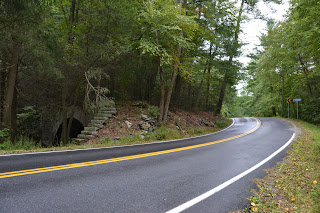


Nearby is a tunnel. It now carries the CSXT RR and formerly the Western Maryland, and before that the Baltimore and Harrisburg Railway Western Extension which incorporated in 1888 and "provided a connection between the original Western Maryland mainline at Highfield and its alternate route, through Gettysburg and Hanover, to Baltimore." [Watts, 1991] You can see on the Tapeworm plan how the railway was to come up from Highfield (close to PA/MD border) to Gettysburg.
The stone viaduct can be found in Adams County on Iron Springs Road.




Details from PA Historical Bridge Data: "The one span, 25'-long, stone arch bridge has voussoirs and spandrel walls with heavy vegetation growing in the earth fill. The bridge was built between 1836 and 1842 as part of the Tapeworm RR, a state sponsored project that was intended to connect Gettysburg with Thaddeus Stevens' iron furnaces in Franklin County. Cuts, embankments, and this stone bridge were completed before the state stopped appropriations and the project was abandoned in 1842. The line was derisively called the Tapeworm RR by its political opponents who saw the meandering line as one of the worst abuses of state-owned internal improvements. As a result of the Tapeworm RR and other canal and railroad projects, the state went heavily into debt. After 1842, state participation in internal improvements declined. The bridge is historically significant for its association with the Tapeworm RR."
Nearby is a tunnel. It now carries the CSXT RR and formerly the Western Maryland, and before that the Baltimore and Harrisburg Railway Western Extension which incorporated in 1888 and "provided a connection between the original Western Maryland mainline at Highfield and its alternate route, through Gettysburg and Hanover, to Baltimore." [Watts, 1991] You can see on the Tapeworm plan how the railway was to come up from Highfield (close to PA/MD border) to Gettysburg.
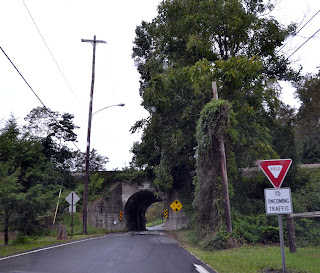 |
| Eastern portal |
 |
| Western portal |
 |
| Heading north east towards Western portal |
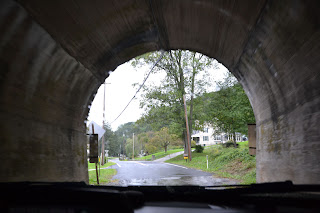 |
| Driving through tunnel heading south west |
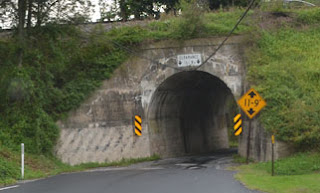 |
| Western portal
SOURCES:
"Railroads of Eastern Franklin County" Randy Watts. Copyright 1991
Pennsylvania Historical Bridge Data, PENNDOT
|

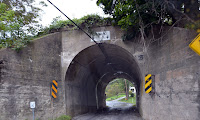
Very nice --- I have been there several times now because of this blog. Thank you !!!!!!!
ReplyDelete